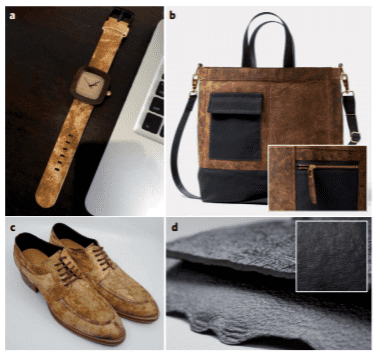These renewable, sustainable materials hold great promise for the future, researchers conclude.
“Fungi-derived leather substitutes are an emerging class of ethically and environmentally responsible fabrics that are increasingly meeting consumer aesthetic and functional expectations and winning favour as an alternative to bovine and synthetic leathers.”

Leather is one of the more common materials in the world. It’s used for anything from shoes and jackets to seat coverings — but it’s becoming somewhat less desirable in recent years. Leather, a co-product of meat production, is ethically questionable (as it involves the slaughtering of animals) and it’s bad for the environment: in addition to the deforestation and grazing required for livestock, there’s also the greenhouse gas emissions and the use of hazardous substances in the tanning process.
Meanwhile, traditional alternatives to leather, like polyvinyl chloride (PVC) or polyurethane (PU), are still based on fossil fuels.
This is where leather-like materials from fungi come into play, which, in general, are CO2 neutral as well as biodegradable at the end of their life span,” says Alexander Bismarck from the Faculty of Chemistry at the University of Vienna.
Bismarck and his colleague Mitchell Jones from the University of Vienna reviewed several studies regarding the production of leather alternatives — specifically, those derived from fungi.
The first advantage of ‘fungi leather’ is that it is at least partially biodegradable. It’s also cheap to grow, making it cost-effective compared to leather. The fungi are basically grown using forestry byproducts such as sawdust, feeding growth for the fungal filaments (called the mycelium).
The literature already contains several studies involving various mushrooms such as the white button mushroom A. bisporus and the bracket fungus D. confragosa. They grow in only a few weeks, and they are then pressed and treated to mimic leather.
“As a result, these sheets of fungal biomass look like leather and exhibit comparable material and tactile properties,” says Alexander Bismarck.
In terms of physical parameters, the resulting material are comparable to leather. Already, several companies working on developing materials derived from fungi, with applications ranging from clothing to construction materials. The researchers also note that woven and felted fabrics are also
sometimes intertwined with mycelium to increase tensile and tear
strength.
The materials are also sustainable since the growth of fungi is effectively carbon neutral since it enables the capture and storage of carbon that would otherwise be emitted to or remain in the atmosphere.
However, there are also challenges, particularly with regard to uniformity. Achieving uniformity is challenging due to the inherent biological variation in fungal growth,
“In addition to being more environmentally sustainable to produce than leather and its synthetic alternatives, as they do not rely on livestock farming or the use of fossil resources, pure fungi-biomass-based leather substitutes are also biodegradable at the end of their service life and cheap to manufacture,” the researchers conclude.
Journal Reference: Nature Sustainability.








